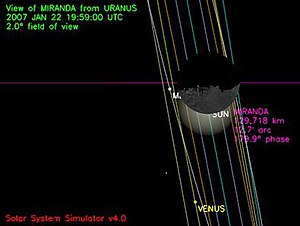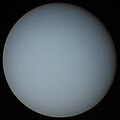天卫五
 | |||||||||
| 发现 | |||||||||
|---|---|---|---|---|---|---|---|---|---|
| 发现者 | 古柏 | ||||||||
| 发现日期 | 1948年2月16日 | ||||||||
| 编号 | |||||||||
| 其它名称 | 米兰达 | ||||||||
| 轨道参数 | |||||||||
| 半长轴 | 129,390公里 | ||||||||
| 离心率 | 0.0013 | ||||||||
| 轨道周期 | 1.413479天 | ||||||||
| 轨道倾角 | 4.232° (相对于天王星赤道) | ||||||||
| 隶属天体 | 天王星 | ||||||||
| 物理特征 | |||||||||
| 大小 | 480×468.4×465.8 km | ||||||||
| 平均半径 | 235.8 ± 0.7 km(地球的0.03697)[1] | ||||||||
| 表面积 | 700 000 km2 | ||||||||
| 体积 | 54 835 000 km3 | ||||||||
| 质量 | 6.59 ± 0.75 × 1019 公斤[2] (地球的1.103 × 10–5) | ||||||||
| 平均密度 | 1.20 ± 0.15 g/cm3[2] | ||||||||
| 表面重力 | 0.079 米/秒2 | ||||||||
| 0.193 公里/秒 | |||||||||
| 自转周期 | 同步自转 | ||||||||
| 转轴倾角 | 0 | ||||||||
| 反照率 | 0.32 | ||||||||
| |||||||||
| 视星等 | 15.8[3] | ||||||||
天卫五,也称为米兰达,是天王星五颗球形卫星中最小和最内侧的卫星。它是杰拉德·古柏在1948年2月16日在美国德州的麦克唐纳天文台发现的,并以莎士比亚的歌剧《暴风雪》中主角普洛斯彼罗的女儿米兰达 (莎士比亚作品人物)命名[4]。像天王星的其它大卫星一样,米兰达的轨道靠近其行星的赤道面。由于天王星是侧躺的绕着太阳运行,因此米兰达的轨道几乎垂直于黄道,并且与天王星一样有着相同的极端气候周期。
到目前为止,只有航海家2号在1986年1月飞越过米兰达南半球时,拍摄过它朝向太阳那一面的近距离特写照。尽管只有这一部分曾被研究过,米兰达仍显示出天王星的系统中最活跃的地质特征。
物理性质

米兰达的表面也许主要是碎冰、低密度硅酸盐和有机化合物组成的岩石。米兰达表面残破有如补丁的地形,表明在这颗卫星上曾有强烈的地质活动进行过,才会有巨大的峡谷交叉往来于表面。
被称为冕状物(coronae)的巨大沟槽结构,可能是被温暖的冰刺穿或涌出造成的[6][7] 。这种作用可能改变了卫星内部的密度分布,也可能造成米兰达自身的重组。[8] 相似的情况相信也曾在土星的卫星恩塞拉都斯发生过。这种活动的能源被认为是来自天王星的潮汐力,可能在过去曾和其他天王星的卫星有轨道共振的关系。
米兰达过去的地质活动相信在轨道离心率比目前大时,曾经历过潮汐加热。在他早期的历史,米兰达曾经和乌伯瑞尔有3:1的轨道共振,之后才从那种状态脱离[9]。共振会使轨道离心率增加,随着时间的变化,由天王星产生的潮汐力引起潮汐摩擦,导致卫星内部被加热。在天王星的系统中,由于行星的扁率和相对于卫星的尺度不是很大,卫星要从共振的轨道中脱离比在木星或土星的系统中容易。对一颗靠近行星的卫星而言,米兰达的轨道倾斜(4.34°)是很大的,因此米兰达能从与乌伯瑞尔的次要的共振中逃逸而出,而这个逃脱的机制相信可以解释为何他的轨道倾斜超过天王星其他大卫星的10倍以上(参见天王星的卫星)[10][11]。
早期的理论,在航海家2号飞掠之后的短时间但现在已经被屏弃了,认为米兰达的前身曾被巨大的撞击击碎掉,然后碎片再重新聚集呈现在这种奇怪的模样[12]。

科学家在米兰达上发现了下列的地质特征:
琐事
- Astronomy Domine:摇滚歌手平克·佛洛伊德创作的一首歌曲,里面提到天卫三、天卫四和米兰达(天卫五)。
参见
参考
- ^ P.C. Thomas. Radii, shapes, and topography of the satellites of Uranus from limb coordinates. Icarus: 427–441. [2018-04-02]. doi:10.1016/0019-1035(88)90054-1. (原始内容存档于2021-02-12).
- ^ 2.0 2.1 R. A. Jacobson, J. K. Campbell, A. H. Taylor, S. P. Synnott. The masses of Uranus and its major satellites from Voyager tracking data and earth-based Uranian satellite data. The Astronomical Journal. June 1992, 103 [2018-04-02]. ISSN 0004-6256. doi:10.1086/116211. (原始内容存档于2017-08-31) (英语).
- ^ Planetary Satellite Physical Parameters. JPL (Solar System Dynamics). 2009-04-03 [2009-08-10]. (原始内容存档于2020-05-21).
- ^ Kuiper, G. P., The Fifth Satellite of Uranus (页面存档备份,存于互联网档案馆), Publications of the Astronomical Society of the Pacific, Vol. 61, No. 360, p. 129, June 1949
- ^ Natural world: the solar system: highest cliffs. Guinness World Records. [2006-08-05]. (原始内容存档于2006-05-21).
- ^ Pappalardo, R. T.; Reynolds, S. J. & Greeley, R. Extensional tilt blocks on Miranda: Evidence for an upwelling origin of Arden Corona. Journal of Geophysical Research (Elsevier Science). 1997-06-25, 102 (E6): 13,369–13,380 [2010-02-22]. doi:10.1029/97JE00802. (原始内容存档于2012-09-27).
- ^ Chaikin, Andrew. Birth of Uranus' Provocative Moon Still Puzzles Scientists. Space.Com. Imaginova Corp. 2001-10-16 [2007-12-07]. (原始内容存档于2008-07-09).
- ^ R., Pappalardo; Greeley, R. Structural evidence for reorientation of Miranda about a paleo-pole. In Lunar and Planetary Inst., Twenty-Fourth Lunar and Planetary Science Conference. Part 3: N-Z: 1111–1112. 1993 [2006-08-05]. (原始内容存档于2019-10-29).
- ^ Tittemore, W. C.; Wisdom, J. Tidal evolution of the Uranian satellites III. Evolution through the Miranda-Umbriel 3:1, Miranda-Ariel 5:3, and Ariel-Umbriel 2:1 mean-motion commensurabilities. Icarus (Elsevier Science). June 1990, 85 (2): 394–443 [2006-10-05]. doi:10.1016/0019-1035(90)90125-S. (原始内容存档于2009-04-22).
- ^ W. C. Tittemore, Wisdom, J. Tidal Evolution of the Uranian Satellites II. An Explanation of the Anomalously High Orbital Inclination of Miranda. Icarus. 1989, 78: 63–89. doi:10.1016/0019-1035(89)90070-5.
- ^ Malhotra, R., Dermott, S. F. The Role of Secondary Resonances in the Orbital History of Miranda. Icarus. 1990, 85: 444–480. doi:10.1016/0019-1035(90)90126-T.
- ^ Chaikin, Andrew. Birth of Uranus' provocative moon still puzzles scientists. space.com. Imaginova Corp. 2001-10-16 [2007-07-23]. (原始内容存档于2008-07-09).
外部链接
- Miranda Profile at NASA's Solar System Exploration site
- Miranda page (页面存档备份,存于互联网档案馆) at The Nine Planets
- Miranda, a Moon of Uranus (页面存档备份,存于互联网档案馆) at Views of the Solar System
- Paul Schenk's 3D images and flyover videos of Miranda and other outer solar system satellites (页面存档备份,存于互联网档案馆)
- Miranda Nomenclature (页面存档备份,存于互联网档案馆) from the USGS Planetary Nomenclature web site (页面存档备份,存于互联网档案馆)
| |||||||||
| |||||||||||||||||||||||||||
| ||||||||||||||||||||||||||||||||||||||||||
| ||||||||||||||||||||||||||||||
Text is available under the CC BY-SA 4.0 license; additional terms may apply.
Images, videos and audio are available under their respective licenses.




